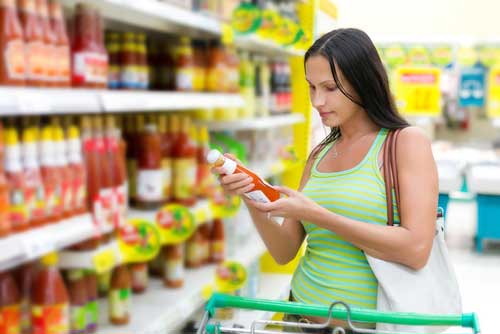
Shopping at the supermarket is slowly becoming more complicated. Ten years ago you didn’t see food labels with phrases like “gluten-free” or “non-GMO” stamped on the front. These days you need a nutritional degree to know what you’re buying. Of course, the best way to avoid the label conundrum is to eat whole, unpackaged foods, but even then you’ll see foods marked “organic.” What do these food labeling terms really mean?
Food Labeling: Gluten-Free – What It Means
What does it really mean when a product is labeled gluten-free? Gluten is a protein found in rye, wheat, and barley. People with celiac disease must avoid even small quantities of gluten since their body mounts an immune response against it. Some people also appear to be “gluten sensitive.” People who are gluten sensitive experience intestinal symptoms like bloating and cramping when they eat foods containing gluten, although they test negative for celiac disease. When you see a gluten-free stamp on packaged products, it means the product can’t contain more than 20 parts of gluten per million. Quantities less than this amount are unlikely to cause problems for people with celiac disease and for those that are gluten sensitive.
To add to the confusion, you’ll see labels that say “no gluten ingredients.” What does this mean? Manufacturers can use this phrase on a label when a product is made from gluten-free ingredients but hasn’t undergone testing to ensure it meets gluten-free standards, less than 20 parts per million. Products made without gluten-containing ingredients can still be cross-contaminated with gluten during processing. If you have celiac disease or a high level of sensitivity to gluten, it’s best to avoid these items due to the small risk of gluten contamination.
Food Labeling: What Does It Mean When Natural is on a Label?
The FDA doesn’t clearly define the term “natural”. It’s vaguely defined as a product that doesn’t contain synthetic chemicals, artificial colorings or synthetic flavorings. This leaves lots of leeway, and manufacturers take advantage of that. For example, a product containing high-fructose corn syrup can carry an all-natural label. So can genetically-modified foods. Despite the FDA’s rather “loose” definition of natural, some products that contain synthetic preservatives or sweeteners still claim to be natural. That’s why it’s important to read the ingredient list carefully. Some consumers also confuse natural with organic. The terms are completely different – one is regulated by the FDA and the other isn’t.
Food Labeling: What Does Organic Mean?
Unlike the term natural that’s only loosely defined and isn’t regulated, organic claims are regulated by the USDA (United States Department of Agriculture). To carry a USDA certified organic seal a product must contain only 100% organically produced ingredients. Organic means no synthetic fertilizers, pesticides or sludge was used to grow an ingredient. In terms of meat, organic regulations state that an animal can’t be treated with growth hormone or antibiotics to enhance growth and must consume organic feed. Organic items cannot contain genetically modified ingredients.
You’ll find some products labeled organic that don’t have the USDA certified organic seal. To be called organic without the seal, the ingredients must be 95% organic and the remaining ingredients must come from an approved list. You’ll also see products that say “made with organic ingredients.” To carry this label, the product must contain 70% or more organic ingredients. What does this mean? You can only be assured a product is 100% organic if it has the USDA certified organic seal on it.
Another caveat – don’t assume organic means an item is healthy from a nutritional standpoint. Packaged organic products may still be high in salt or sugar and contain a long list of ingredients. Dig deeper by reading the nutritional label and the ingredient list carefully.
GMO Food Labeling
A lot of controversies exists about genetically modified ingredients (GMOs) and whether products that contain them should be mandatorily labeled. As the battle wages on, some food manufacturers allow their products to be independently tested by a non-profit service called the non-GMO project. Products that pass their testing can display a “non-GMO project verified” stamp. Displaying the stamp doesn’t guarantee a product is completely free of GMOs due to the limitations of current testing but it does add a level of reassurance that a product is in compliance with the non-GMO project’s high standards.
Here’s another thing to keep in mind. Some manufacturers label their products as GMO-free but these claims aren’t verified by third-party testing. The non-GMO project is the only organization that offers independent, third-party testing for GMOs at the present time. Another way to avoid GMOs is to buy organic products that bear the USDA Certified Organic seal. These products, by law, cannot contain genetically modified ingredients.
Are GMOs safe? Some studies in animals raise concerns about GMO safety, although there are no studies showing harm to humans. On the other hand, there are no long-term studies in humans showing they’re safe either. At the very least they need more study.
The Bottom Line?
There are a growing number of food labels to be aware of when you shop. Don’t be too quick to take them at face value. Your definition of “natural” and a food manufacturer’s definition may be quite different. Natural doesn’t mean free of pesticides either. If you’re concerned about pesticides, look for the USDA certified organic seal on the package. Keep in mind that none of the above labels mean a product is healthy. You have to read the nutritional information and ingredient list to determine that.
References:
U.S. Food and Drug Administration. “Questions and Answers: Gluten-Free Food Labeling Final Rule”
Eatocracy. “USDA approves voluntary GMO-free label”
Business Insider. “In US, ‘Natural’ Food Label Means Nothing”
Non-GMO Project. “THE “Non-GMO Project Verified” Seal
Related Articles By Cathe:
The Sometimes Confusing World of Meat Substitutes

